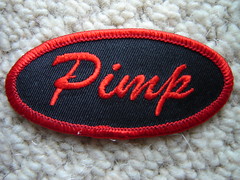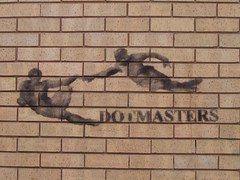I’ve now discovered that Voicethread takes text well, allowing voice comments (that’s a very useful feature). It also does a reasonable job with video, too and similarly you can comment by voice or in writing. This looks like quite an idyllic scene, but actually it’s just off the main road. The brass band is a legacy of the Victorian industrial era – seen as a wholesome pursuit for the working classes of pit, mill and factory workers. Here, the Holymoorside Brass Band plays in front of the Revolution House (built sometime in the 1600s). So we have all sorts of layers of meaning in a single event.
Saturday, May 31, 2008
Interval
Thursday, May 29, 2008
Interest
I was quite impressed by the sort of techniques that David Gauntlet’s been using to model identity. He sounds a bit like the Jools Holland of academia - but the video does more than simply advertise his book Creative Explorations. He shows some examples of his work and talks about its possible applications. I guess I’m linking this up with the sort of reflections I’ve been writing about with respect to the Pandorama and Theatro del Oprimido.
Sunday, May 25, 2008
Interpellation

badge
There is something a little too simplistic about Goffman’s dramaturgical account of identity (in The Presentation of Self in Everyday Life). Although I like the notion of performance, the influence of the other is somewhat problematic. “…when the individual presents himself before others, his performance will tend to incorporate and exemplify the officially accredited values of society.” (1969:45); but also in here there is the notion of an essential self that does the performance, and this is unconvincing. Better is Butler’s notion of interpellation in which others call us into being. Moreover Butler does not suggest that we perform a script or enact a discursive practice, but rather that the individual, or the self, is a result of discursive practices. There is no prior entity. Herein lies the distinction between performativity and performance. What we refer to as our identity, then, is the story supplied by the manipulation and re-combination of available resources, mediated through text, called into being through our interaction with others.
Saturday, May 24, 2008
Interactivity

Dotmasters
I was at the Children in Virtual Worlds conference on Thursday (here). It was a bit of a mixed bag. Each time a really interesting topic came up, it tended to get left unexplored. A constant theme was the issue of interactivity and the regulation and surveillance of interaction. I realized, not for the first time, that the concept of interaction has quite range of interpretations. You could perhaps identify five possibilities. 1.o nline content encourages you to make a reponse (you think, learn, go and get something, phone in); 2. you perform an action and it is logged (you vote; rate or rank); 3. you communicate verbally or otherwise with others (comment; chat; tag etc.); 4. your actions change the screen environment (you post or personalize your page or portal, or adapt your pov); 5. Your collaborative endeavours result in a transformation of the environment you’re in (you co-construct). From this you arrive at some nuances of interactivity. They are: not all interactivity directly involves other human subjects; not all interactivity promotes social interaction; not all interactivity involves collaboration. Web 2.0 apps and SNS allow for different kinds of interactivity.
Tuesday, May 20, 2008
Classroom 2.0
With only one slide and 156 comments this voicethread illustrates the wisdom of crowds effect of Web 2.0. I suppose we need to ask about the benefits here, and whether or not this fulfills a useful purpose. It's great to have all those voices, but frankly I got bored. Maybe it would be different if I'd initiated it, because there's something much more attractive about the comments I get as opposed to the comments others get! When I'm reading blogs, I usually tend to skip the comments unless, of course, I've left a comment and go to check to see if there's a reply. There's a sort of self-presentation thing going on here. I wonder if that's why learning blogs tend to work better than bulletin boards, the sense of ownership, of it being my space in which I perform my identity, and then later, check to see how it went down?
Monday, May 19, 2008
Image and voicethreads
It feels a bit like arriving late at the party, but I’m just looking at the learning potential of voicethreads. This is because I'm getting interested in how visual images can help us to reflect, help us to see things differently, to make the familiar strange and to capture or frame our experience in new ways. On Saturday we had a ball, taking still images and recording and writing comments. I got the sense that you begin to move beyond your own particular idea by building on the perspectives of others. OK, I suppose we were just messing about with the affordances of the technology, but there’s more here than meets the eye!
Thursday, May 15, 2008
Electronic blurrings

blurrings
In a tantalizingly brief post, Torill Mortensen comments that in the late modern world, time and space are the only real values. I wished there had been more. I was reminded of Meyrowitz’s No Sense of Place (1985) in which he argues that with new media: what is happening almost anywhere can be happening wherever we are (p.125). Recently Meyrowitz has turned his attention to the blurrings of time and space that come with mobile technologies. In this essay (pdf) he describes how: electronic information seeps through walls and leaps across vast distances. While we still often think of electronic media as simply connecting one place to another more quickly, our forms of communication have been subtly but significantly altering the environments we live in, transforming them into social places in which we are becoming new people. (p.97) This comes from the essay Global Nomads in this book. This reminds us of Ito and Okabe’s technosocial spaces. But Meyrowitz makes some other useful observations, too. For instance literacy he suggests: encourages the splintering of identities based on levels of reading ability and sets and subsets of literatures (p.93). And later he approaches that idea of linear development from a different perspective: the old, year-by-year, staggered access to information, where children of each age and reading level were exposed to entirely different sets of information, is largely bypassed (p.95). What a massive challenge for models of education!
Monday, May 12, 2008
It is time

It is time
Is there such a term as hypermodification? If not then linguists should coin it, because I reckon I've noted a trend in the use of additional modifying prefixes. I first spotted it on a news bulletin in which one politician was accusing another of over-hyping a new initiative. Now I thought hyping already suggested a sort of inflation of claims, an exageration, so where does that leave hyping? As a normal state? Anyway here I found that it is defined as: To promote or publicize to excess. So the second example is from Hannah who pre-warned me about the heat in London. I loved this idea of being pre-warned, implying, as it does, that you've been given notice that you will be warned. However, on checking, this has more of a provenance - to warn beforehand faetures in Webster's 1913 dictionary. You could say that pre-warn is alternative to forewarn. Pre-warn reminded me of pre-hear which is becoming quite popular too. Logic is always a difficult thing to apply to language, but my initial thought was that pre-hear made no sense at all - you either heard something or you didn't. You couldn't hear it before you've heard it. But then I've recently seen it compared to previewing, in other words it's about listening to a something (eg music) before it's actually released. That makes sense. OK, well if there are other examples of hypermodification, let's hear them.
Sunday, May 11, 2008
GTA4 v 1688

Revolution House
The urban environment has been saturated by images from Grand Theft Auto 4, to coincide with jubilant reports about the games media conquest and record-breaking sales. Video-gaming challenges Hollywood, or so the stories go. It’s interesting to think how non-gamers could hardly fail to notice the invasion of GTA 4. So where does 1688 come in? Well I just wanted to point out some similarities against the more obvious differences. In 1688, in the lead up to the Glorious Revolution, William of Orange exploited the potential of what was then the new media, by having thousands of copies of his pamphlets stashed away in secret locations, embargoed until the precise time of the invasion. Here’s the link. First the technology of mass production for creating billboard posters, handbills and so on. Second the strategic release and distribution to key sites and third, appealing and available content. They work together. So that’s the recipe for a fairly painless invasion. Now do you want to play the game?
Friday, May 09, 2008
Business

near you
Carphone’s Andrew Harrison has pledged to transform the UK broadband market, just as he did with mobile phones. His move to give a laptop free (to keep - as the ad says) with every broadband connection could well have a significant impact on home wireless connectivity in this country. The promotion has already started on TV (perhaps it’s too early to see the take-up) but we've heard no comment about the laptops themselves, but one presumes they’re at least good enough, or else Carphone will end up with egg on their corporate faces.
Thursday, May 08, 2008
The information

Hearts of the broken
Good YouTube stats are hard to come by, so I’ve been talking to those I meet. It strikes me that there are far more consumers than producers, and most people don’t even bother to comment. Looking for humour, parody and music seem pretty high on the casual vistors list. The users I talk to often refer to word-of-mouth recommendation. There’s some garden path surfing through related videos but not a lot. Here’s some (old) information on patterns of use and here’s the buzz on site meter type stats on your own uploads, that's just been made available.
Wednesday, May 07, 2008
YouTube (again)

Anarchy in the UK
The ephemeral texts produced in that nexus of popular culture, new technology and literacy are of enduring interest. Web 2.0 voices tend to be un-edited and un-censored, and as a result the texts that are produced are often, in one way or another, contentious. Looking at a YouTube video that has attracted a massive number of views, and an impressive list of comments, I was struck by the passions ignited by a low-grade mash-up of a football pitch incident. The un-regulated stream of comment was perhaps predictable. A public display of taunting, trading insults, and of taking sides - and much of the writing peppered with expletives and derogatory references . Much of it is in the demotic of grafitti - not the chic high-end street art stuff - I mean the raw edged stuff, crude and rude as it is, the material we choose not to photograph and put up on Flickr. I must say I don't find it offensive, but I was troubled, but perhaps not surprised, by the shades of racism and sexism that run through the banter. That made me wonder how we stand as educators in relation to this. I realised that I couldn't subscribe to a total Web 2.0 is wonderful view any more than I could to a ban this rubbish stance. I'm convinced that we need to engage with it, we can't turn our backs on it, pretending it isn't there, or naively accept that everything in the world of popular technoculture has a rosey glow. It's just as it is - a galaxy of practices - but we need to find ways of engaging with it, critiquing it, and harnessing the tools. It's out there, laid bare!
Tuesday, May 06, 2008
Learning from YouTube

Janet ponders
Today, DrJ and I were thinking through some of the issues around YouTube and formal education. We concluded that there’s plenty of potential for textual study and critical reading (the media studies bit), but there are difficulties when it comes to using it as a learning tool. One of the difficult issues is the rather chaotic nature of YouTube -for instance, there seems to be absolutely no logic governing the related videos section. It might as well be random. You’re as likely to stumble on dodgy humour, soft porn or parody - it encourages garden-path connections. Here’s a report on a YouTube course. I liked the six binaries (bottom of the page) but was uncertain about how these are construed as limitations. This is another report on the same course and here’s Henry Jenkins interviewing Alex Juhasz (who taught the course). Part One and then Part Two.
Monday, May 05, 2008
The text

The posse
May Bank Holiday. I've been taking a bit of a break. There have been some rather dismall local election results and a worrying rise in BNP voting. I can't see much hope for a London with Boris, but we'll see. Meanwhile I'm just on the look out for some good academic work on video-sharing...and, as promised here's a direct link to Jackie's inaugural (to go with the picture). Oh so multimodal...which reminds me , Sigrid has this link to the king of multimodality, click here, it's a corker!
Subscribe to:
Comments (Atom)